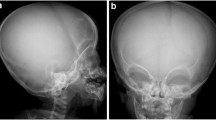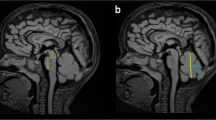Abstract
Background
Thanatophoric dysplasia (TD) and hypochondroplasia are both caused by FGFR3 (fibroblast growth factor receptor 3) gene mutations. Temporal lobe dysplasia has been well described in thanatophoric dysplasia; however, only a couple of anecdotal cases of temporal lobe dysplasia in hypochondroplasia have been described.
Objective
To define temporal lobe abnormalities in patients with hypochondroplasia, given that they share the same genetic mutation.
Materials and methods
We identified brain imaging studies of nine children with hypochondroplasia. The temporal lobes were assessed on CT and MRI for size and configuration of the temporal horn and aberrant sulcation of the inferior surface of the temporal lobe.
Results
All children had a triangular-shape temporal horn and deep transverse fissures of the inferior temporal lobe surface. Neuroimaging in our cohort revealed enlarged temporal lobes and oversulcation of the mesial temporal and occipital lobes, with abnormal inferomedial orientation of these redundant gyri. Hippocampal dysplasia was also universal.
Conclusion
We confirmed frequent inferomesial temporal and occipital lobe abnormalities in our cohort of children with hypochondroplasia. Murine models with mutant fgfr3 display increased neuroprogenitor proliferation, cortical thickness and surface area in the temporo-occipital cortex. This is thought to result in excessive convolution and likely explains the imaging findings in this patient cohort. (Note that fgfr3 is the same genetic mutation in mice as FGFR3 is in humans.)







Similar content being viewed by others
References
Vajo Z, Francomano CA, Wilkin DJ (2000) The molecular and genetic basis of fibroblast growth factor receptor 3 disorders: the achondroplasia family of skeletal dysplasias, Muenke craniosynostosis, and Crouzon syndrome with acanthosis nigricans. Endocr Rev 21:23–39
Francomano CA et al (1999) Hypochondroplasia. In: Pagon RA, Bird TD, Dolan CR (eds) GeneReviews (Internet). University of Washington, Seattle, Updated 2005. http://www.ncbi.nlm.nih.gov/books/NBK1477/
Hevner RF (2005) The cerebral cortex malformation in thanatophoric dysplasia: neuropathology and pathogenesis. Acta Neuropathol 110:208–221
Coulter CL, Leech RW, Brumback RA et al (1991) Cerebral abnormalities in thanatophoric dysplasia. Childs Nerv Syst 7:21–26
Miller E, Blaser S, Shannon P et al (2009) Brain and bone abnormalities of thanatophoric dwarfism. AJR Am J Roentgenol 192:48-51
Knisely AS, Ambler MW (1988) Temporal-lobe abnormalities in thanatophoric dysplasia. Pediatr Neurosci 14:169–176
Kannu P, Hayes IM, Mandelstam S et al (2005) Medial temporal lobe dysgenesis in hypochondroplasia. Am J Med Genet A 138:389–391
Grosso S, Farnetani MA, Berardi R et al (2003) Medial temporal lobe dysgenesis in Muenke syndrome and hypochondroplasia. Am J Med Genet A 120A:88–91
Senapati GM, Levine D, Smith C et al (2010) Frequency and cause of disagreements in imaging diagnosis in children with ventriculomegaly diagnosed prenatally. Ultrasound Obstet Gynecol 36:582–595
Kannu P, Aftimos S (2007) FGFR3 mutations and medial temporal lobe dysgenesis. J Child Neurol 22:211–213
Francomano CA (1999) Hypchondroplasia. In: Pagon RA, Bird TD, Dolan CR et al (eds) GeneReviews (Internet). University of Washington, Seattle, Available via http://www.ncbi.nlm.nih.gov/books/NBK1477
Iwata T, Hevner RF (2009) Fibroblast growth factor signaling in development of the cerebral cortex. Dev Growth Differ 51:299–323
Inglis-Broadgate SL, Thomson RE, Pellicano F et al (2005) FGFR3 regulates brain size by controlling progenitor cell proliferation and apoptosis during embryonic development. Dev Biol 279:73–85
Thomson RE, Kind PC, Graham NA et al (2009) Fgf receptor 3 activation promotes selective growth and expansion of occipitotemporal cortex. Neural Dev 4:4
Conflicts of interest
None
Author information
Authors and Affiliations
Corresponding author
Rights and permissions
About this article
Cite this article
Philpott, C.M., Widjaja, E., Raybaud, C. et al. Temporal and occipital lobe features in children with hypochondroplasia/FGFR3 gene mutation. Pediatr Radiol 43, 1190–1195 (2013). https://doi.org/10.1007/s00247-013-2684-3
Received:
Revised:
Accepted:
Published:
Issue Date:
DOI: https://doi.org/10.1007/s00247-013-2684-3




